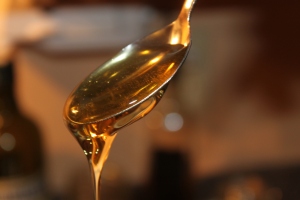Our honeybees and hive had a good first year at the farm – and now that the cold of winter has arrived – they have begun their own version of hibernation. In reality – honeybees do not officially hibernate – instead opting to cluster together to form a protective ball around the all important queen. As they cluster, they move and fan their wings about to increase the temperature of the hive and keep the queen safe and warm.
The honeybees are an important part of our farm and its future success. Not only do they provide us with all of our honey needs throughout the year – they also provide by helping to pollinate all of our fruit trees, grapevines and vegetable and flower plantings. In fact, they help so much that we will be increasing the hive total from one to three next spring.
Although we do perform a couple of tasks to help them make it through the winter – honeybees are amazing at taking care of themselves and perform most of their own “winterizing” duties.
For our part, we insert a reducer into the main hive body to keep out cold drafts and help to deter small mice or varmints that may try to rob the honey stored inside. Since this is the first full year for our new hive – we also left all of the honey on the bottom two sections in place for them to have for winter use. The honey is what they will consume to have the energy for all of that wing flapping and temperature control. Some will also supplement the stored honey and feed their bees through the winter – but if you have a healthy hive with plenty of stored honey – it is not necessary. In addition, many beekeepers think that feeding bees through the winter only serves to attract predators and robbers to the hive.

The bees should be nice and warm in their hive – even when the farm is covered in a fresh blanket of snow.
The honeybees on the other hand are the real workers who prepare their hive for winter. By now – they have been all around the hive sealing up tiny cracks and holes with propolis – a sticky thick substance they secrete to seal out the winter. They have also reduced their overwinter population by forcing a large majority of the male bees out into the cold to die. It may sound harsh – but the male bees perform no work related duties in the hive, and are simply not needed through the winter months.
If the temperature rises above the 50 to 55 degree mark at any point throughout the winter – some of the bees will forage out and about to make what are called cleansing flights. This helps to keep the inside of the hive clean. Beyond that – they stay in that tight cluster awaiting the arrival of spring – much like humans – except we spend it clustered in blankets near a warm fire! 🙂
Happy Gardening -Jim and Mary
**If you would like to receive our Sunday Farm Update each week – be sure to sign up to follow the blog via email in the right hand column, “like” us on the Facebook, or follow us on Twitter.


